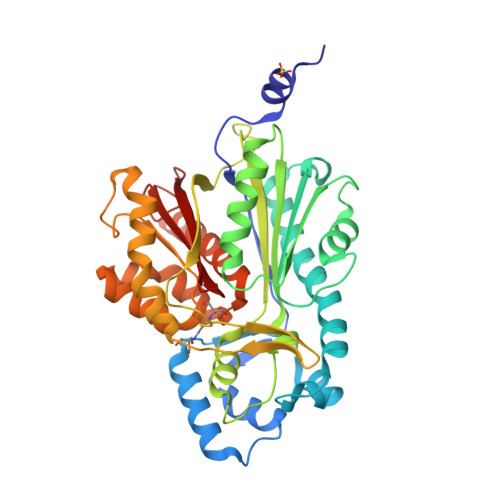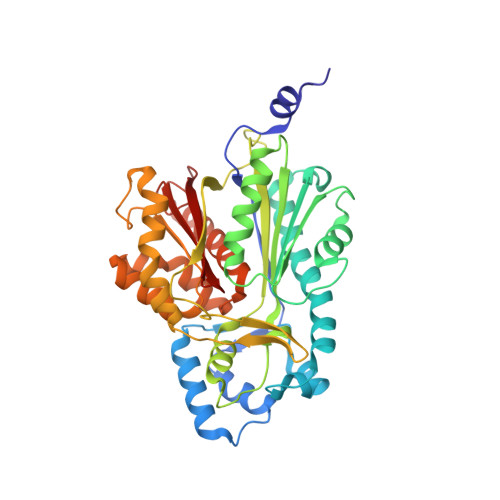Dissection of malonyl-coenzyme A decarboxylation from polyketide formation in the reaction mechanism of a plant polyketide synthase.
Jez, J.M., Ferrer, J.L., Bowman, M.E., Dixon, R.A., Noel, J.P.(2000) Biochemistry 39: 890-902
- PubMed: 10653632
- DOI: https://doi.org/10.1021/bi991489f
- Primary Citation of Related Structures:
1D6F, 1D6H, 1D6I - PubMed Abstract:
Chalcone synthase (CHS) catalyzes formation of the phenylpropanoid chalcone from one p-coumaroyl-CoA and three malonyl-coenzyme A (CoA) thioesters. The three-dimensional structure of CHS [Ferrer, J.-L., Jez, J. M., Bowman, M. E., Dixon, R. A., and Noel, J. P. (1999) Nat. Struct. Biol. 6, 775-784] suggests that four residues (Cys164, Phe215, His303, and Asn336) participate in the multiple decarboxylation and condensation reactions catalyzed by this enzyme. Here, we functionally characterize 16 point mutants of these residues for chalcone production, malonyl-CoA decarboxylation, and the ability to bind CoA and acetyl-CoA. Our results confirm Cys164's role as the active-site nucleophile in polyketide formation and elucidate the importance of His303 and Asn336 in the malonyl-CoA decarboxylation reaction. We suggest that Phe215 may help orient substrates at the active site during elongation of the polyketide intermediate. To better understand the structure-function relationships in some of these mutants, we also determined the crystal structures of the CHS C164A, H303Q, and N336A mutants refined to 1.69, 2.0, and 2.15 A resolution, respectively. The structure of the C164A mutant reveals that the proposed oxyanion hole formed by His303 and Asn336 remains undisturbed, allowing this mutant to catalyze malonyl-CoA decarboxylation without chalcone formation. The structures of the H303Q and N336A mutants support the importance of His303 and Asn336 in polarizing the thioester carbonyl of malonyl-CoA during the decarboxylation reaction. In addition, both of these residues may also participate in stabilizing the tetrahedral transition state during polyketide elongation. Conservation of the catalytic functions of the active-site residues may occur across a wide variety of condensing enzymes, including other polyketide and fatty acid synthases.
Organizational Affiliation:
Structural Biology Laboratory, The Salk Institute for Biological Studies, 10010 North Torrey Pines Road, La Jolla, California 92037, USA.


















